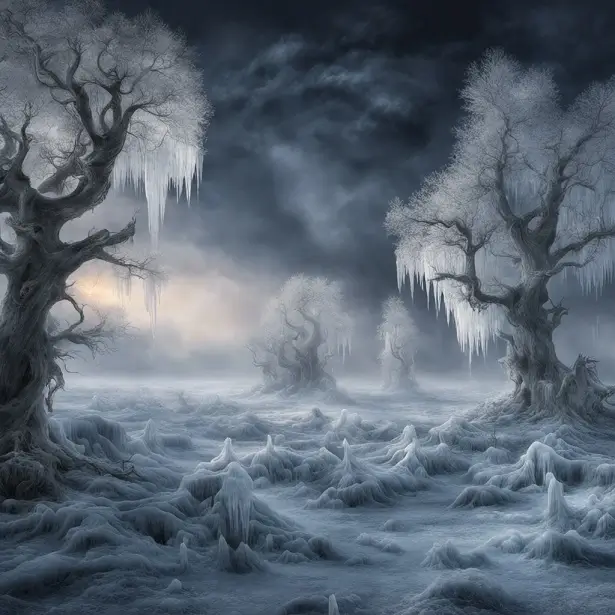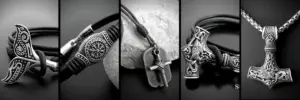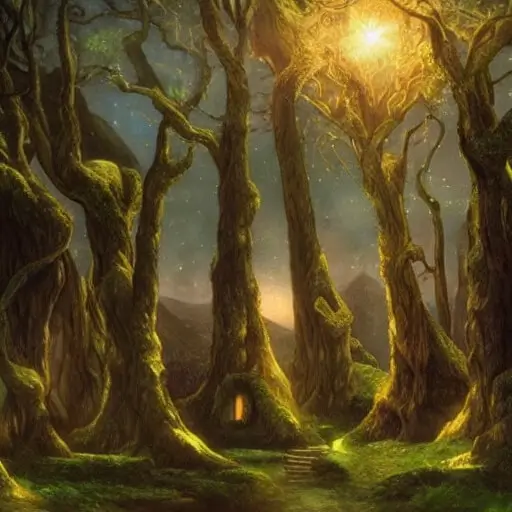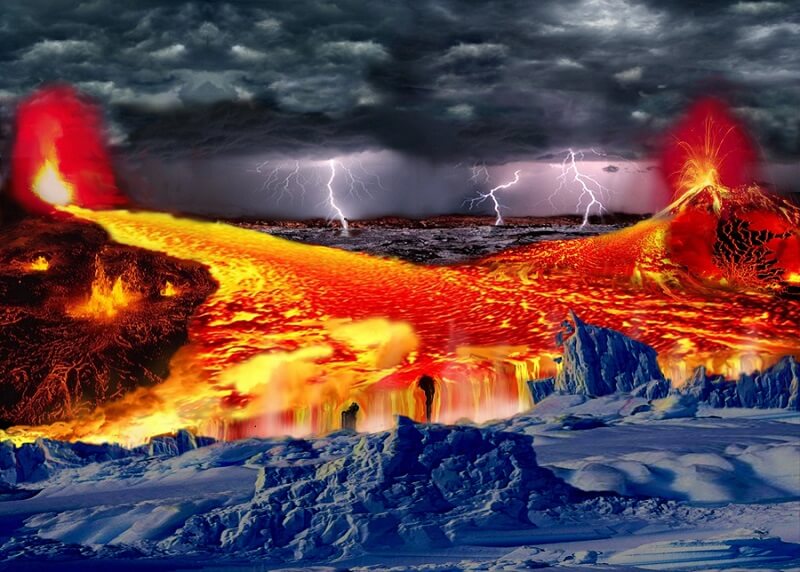In Norse cosmology, Niflheim is one of the nine worlds and one of the two primordial realms that existed at the dawn of creation. Translating to “Mist Home” or “Mist World” in Old Norse, Niflheim represents the elemental forces of ice, cold and darkness.
Along with its fiery counterpart Muspelheim, the realm of Niflheim helped set the stage for the emergence of life and the cosmos.
What readers will learn from this article:
- Cosmological Role of Niflheim: Understand how Niflheim, along with Muspelheim, played a fundamental role in the creation of the Norse cosmos, serving as a backdrop for the emergence of life and the universe.
- Interaction with Muspelheim: Explore how the interaction between Niflheim’s icy mists and Muspelheim’s fiery forces led to the creation of the first beings in Norse mythology, Ymir and Audhumla.
- Major Features of Niflheim: Discover the unique characteristics of Niflheim, including its perpetual cold, darkness, the sacred spring Hvergelmir, and the eleven mythical rivers originating from it.
- Niflheim’s Association with Helheim: Differentiate between Niflheim and the underworld realm of Helheim, understanding that only those who died unglorified were believed to go to Helheim.
- Niflheim’s Harsh Natural Forces: Explore how Niflheim embodies untamed and chaotic forces that exist beyond the boundaries of civilization.
- Norse Concept of Balance: Gain insight into the ancient Norse belief in the balance between extreme elements, as exemplified by the contrast between Niflheim’s cold and Muspelheim’s heat.
- Niflheim’s Role in Ragnarok: Learn how Niflheim played a pivotal role in the cataclysmic events of Ragnarok, where it clashed with Muspelheim to bring about the destruction and rebirth of the cosmos.
Overview of Niflheim
Niflheim was one of two primordial realms in Norse mythology, the other being Muspelheim. These two realms existed independently in the void of Ginnungagap before creation began.
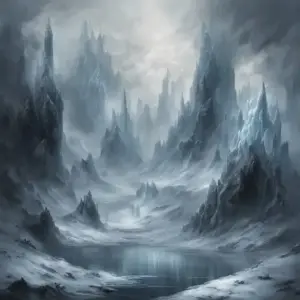
Niflheim
Niflheim represented absolute cold, ice and darkness, while Muspelheim represented heat and fire.
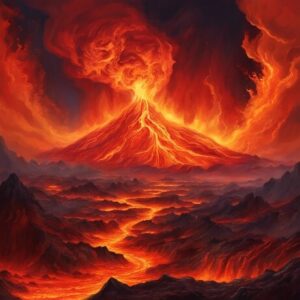
Muspelheim
When the icy mists of Niflheim eventually came into contact with the glowing sparks of Muspelheim, their interaction led to the emergence of the first beings in the Norse genesis myth – the giant Ymir and the cow Audhumla.
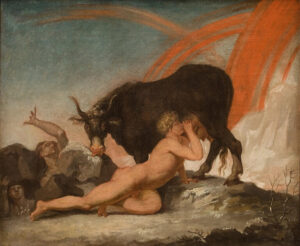
Ymir and the cow Audhumla
From these two primordial beings descended the various races of gods, giants and humans that populated the Norse cosmos.
Niflheim is characterized by perpetual gloom, freezing mist, icy landscapes and darkness. This makes it the stark opposite of Muspelheim and its fiery nature. This contrast between extreme cold and heat reflects the ancient Norse religious concept of two competing primal forces that needed to be kept in balance.
At the heart of Niflheim lies the spring Hvergelmir, from which originates eleven rivers that nourish the roots of the world tree Yggdrasil and thereby sustain it. The anchored tree roots in turn help stabilize Niflheim.
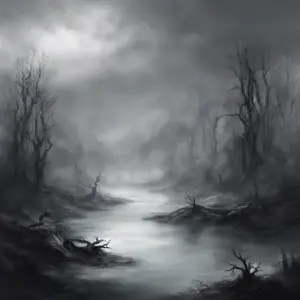
Niflheim with the river Hvergelmir
While Niflheim is sometimes incorrectly conflated with Hel or Helheim, the underworld realm presided over by the goddess Hel, they are in fact separate planes of existence. Only those unglorified souls who perished from illness or old age were believed to go to Helheim, not heroic spirits or the honored battle-slain.
Niflheim meanwhile was inhabited by more chaotic forces, including the monstrous dragon Nidhogg who gnawed on Yggdrasil’s roots along with its brood of serpents. The realm represented wild, untamed forces outside the boundaries of civilization.
| Feature | Description |
|---|---|
| Cosmological Role of Niflheim | One of two primordial realms in Norse mythology, setting the stage for creation. |
| Interaction with Muspelheim | The icy mists of Niflheim met the fiery Muspelheim, giving rise to the first beings Ymir and Audhumla. |
| Perpetual Cold and Darkness | Niflheim is characterized by perpetual cold, darkness, and icy landscapes. |
| The Sacred Spring Hvergelmir | Hvergelmir is the heart of Niflheim, the sacred spring from which eleven mythical rivers originate. |
| Niflheim’s Association with Helheim | Niflheim and Helheim are separate realms; only those who died unglorified went to Helheim. |
| Representation of Harsh Natural Forces | Niflheim embodies wild, untamed forces beyond the boundaries of civilization. |
| Norse Concept of Balance | The extreme cold of Niflheim contrasting with Muspelheim’s heat represents the Norse idea of balance. |
| Niflheim’s Role in Ragnarok | The cataclysmic clash with Muspelheim during Ragnarok led to the destruction and recreation of the cosmos. |
| Mentions in Eddas and Norse Literature | Niflheim’s presence in Snorri Sturluson’s Prose Edda and singular mentions in poetic Eddas. |
Niflheim in Norse Cosmology and Myth
As described in Snorri Sturluson’s Prose Edda, Niflheim and Muspelheim were the first worlds to take shape in the void of Ginnungagap that predated creation.
Sparks and molten lava from Muspelheim met the ice of Niflheim across Ginnungagap. From the melting ice formed the giant Ymir, considered the progenitor of the race of frost giants. Ymir was nourished by the cow Audhumla, who also emerged from the ice and had rivers of milk flow from her teats.
While Ymir fed on Audhumla’s milk, Audhumla licked the ice for sustenance. She uncovered Buri, the first of the Aesir gods and grandfather of Odin. Buri had a son named Borr who married a giantess named Bestla. Their sons Odin, Vili and Ve created the heavens and earth out of Ymir’s slain body.
According to Snorri Sturluson, after Odin and his brothers created the cosmos, he consigned the goddess Hel, daughter of Loki, to rule over Niflheim. Those who died ingloriously of disease or old age went to Helheim to reside under her.
The fiery Muspelheim and icy Niflheim collided again during Ragnarok, the cataclysmic battle that destroyed the old world and led to the emergence of a new era after a great flood.
Landscape and Features of Niflheim
Niflheim was a stark, gloomy realm locked in perpetual winter darkness. The land was made of ice and frost, wreathed in freezing mist. It was akin to the Arctic landscape of northern Norway and Iceland but colder and shrouded in twilight.
At the heart of Niflheim was the spring Hvergelmir (“Roaring Cauldron”) from which originated eleven rivers, including Svöl, Gunnthra, Fjörm, Slidr, Hrid and Gjöll. These rivers flowed throughout the nine worlds, connecting Niflheim via the well to Yggdrasil and providing water to its roots. They were thereby integral to the tree’s survival.
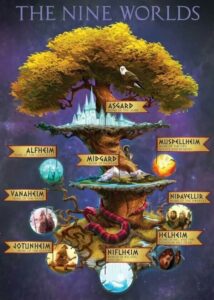
The icy rivers also served as pathways for spirits of the dead traveling to the afterlife. The river Gjöll separated the underworld realm of Hel from the rest of Niflheim.
Mentions in the Eddas and Norse Literature
Niflheim appears prominently in Snorri Sturluson’s Prose Edda where its primal icy nature is emphasized. But it is absent from older poetic Eddas and sources, where the underworld is referenced as Niflhel and Hel. The singular mentions are:
- Prose Edda: Discussed in the Gylfaginning as one of two primordial realms fundamental to creation. Also referenced in relation to Yggdrasil and as the place where Hel resides.
- Poetic Edda – Vafthrudnismal: Hint at the icy rivers of Niflheim flowing into Ginnungagap.
- Hrafnagaldr Óðins: Brief allusion to Niflheim as a location in the north where the sun did not shine.
The conflation of Niflheim and Hel in some sources and differences across texts has led to some debate over whether Snorri devised Niflheim himself. But the realm’s symbolism is clear, contrasting with Muspelheim to represent the extremes of hot and cold.
Interpretations and Significance
As one of two primordial realms along with Muspelheim, Niflheim represented absolute cold, darkness and mist. This stark icy realm encapsulated raw natural forces outside civilization.
Its freezing waters brought life but also symbolized hardship and obstacles facing warriors traveling to Valhalla or the underworld. Niflheim’s rivers connected it to all realms as water sources but also divided it from other realms.
The realm’s harsh inhospitable environment signified the struggles of life but also the resilience of Norse culture in extreme northern climates. Its darkness juxtaposed with Muspelheim’s fire underscored the ancient Northern European concept of balance between extremes.
Overall, Niflheim stands in Norse mythology as a fundamental building block of creation alongside Muspelheim. Its treacherous icy waters both nurtured the great tree Yggdrasil and swept away souls to their final destinations after death.
Niflheim in Norse Culture: A Closer Look at Resilience and Balance
Niflheim, often overlooked in its cultural implications, offers a unique lens through which to explore the remarkable resilience of the Norse people.
Beyond its cosmic symbolism, the relentless cold and unforgiving darkness of Niflheim mirror the daily hardships faced by Vikings. These environmental challenges weren’t just obstacles; they were the crucible in which the Norse spirit was forged. Niflheim’s freezing waters were not just barriers but pathways for the intrepid warriors who journeyed to Valhalla or ventured into the underworld.
Niflheim’s role as the embodiment of extreme natural forces highlights the delicate balance cherished by the ancient Northern Europeans. The coexistence of Niflheim’s cold and Muspelheim’s fire underscores the Norse concept of equilibrium. It serves as a reminder that the Viking way of life was intricately tied to the stark realities of their environment.
In essence, Niflheim goes beyond its role in myth; it serves as a testament to the Norse people’s ability to thrive in the face of adversity and their unwavering commitment to maintaining balance in a world dominated by extremes. This perspective adds a unique dimension to our understanding of Niflheim and its cultural significance
Key features about Niflheim:
| Feature | Description |
|---|---|
| Cosmological Role of Niflheim | One of two primordial realms in Norse mythology, setting the stage for creation. |
| Interaction with Muspelheim | The icy mists of Niflheim met the fiery Muspelheim, giving rise to the first beings Ymir and Audhumla. |
| Major Features of Niflheim | – Perpetual cold, darkness, and icy landscapes. <br> – The sacred spring Hvergelmir and its 11 mythical rivers. |
| Niflheim’s Association with Helheim | Niflheim and Helheim are separate realms; only those who died unglorified went to Helheim. |
| Niflheim’s Harsh Natural Forces | Represented wild, untamed forces beyond civilization. |
| Norse Concept of Balance | Niflheim’s cold contrasting with Muspelheim’s heat represents the Norse idea of balance. |
| Niflheim’s Role in Ragnarok | Clash with Muspelheim during Ragnarok led to the destruction and recreation of the cosmos. |
| Landscape and Features of Niflheim | – Perpetual cold, darkness, freezing mist, icy terrain. <br> – Spring Hvergelmir and its rivers, including Gjöll, connecting to Yggdrasil. |
| Mentions in Eddas and Norse Literature | – Appears prominently in Snorri Sturluson’s Prose Edda. <br> – Singular mentions in poetic Eddas. |
FAQs About Niflheim
What is Niflheim in Norse mythology?
Niflheim is one of the two primordial realms in Norse mythology that existed at the dawn of creation. It represented absolute cold, ice and darkness.
What does the name Niflheim mean?
In Old Norse, Niflheim means “Mist Home” or “Mist World”, referring to the primordial world of ice, cold and darkness.
Where is Niflheim located?
Niflheim is one of the nine worlds in Norse cosmology. It was one of two primeval realms that existed before creation, representing absolute cold and darkness.
What was Niflheim’s role in Norse creation myths?
Niflheim’s icy rivers mixed with the fires of Muspelheim in Ginnungagap to form the first beings – Ymir, Audhumla and Buri. Their descendants became the races of gods, giants and humans.
What is the well Hvergelmir and where is it located?
Hvergelmir is a sacred well located in Niflheim, sometimes referred to as the “Roaring Cauldron”. It was the source of eleven mythical rivers that nourished Yggdrasil’s roots.
How is Niflheim connected to Ragnarok?
During Ragnarok, the fiery realm of Muspelheim clashed with the icy realm of Niflheim, destroying the old world order. This allowed for the emergence of new life and creation from the waters.
Are Niflheim and Helheim the same?
No, Niflheim and Helheim are separate planes in Norse cosmology. Niflheim represented cold and darkness while Helheim was the underworld realm ruled by Hel where only the dishonored dead were sent.
Who lives in Niflheim in Norse mythology?
Niflheim is inhabited by chaotic forces like the dragon Nidhogg and his brood of serpents who gnaw on the roots of Yggdrasil. It represents untamed natural forces outside civilization.
What did the landscape of Niflheim look like?
Niflheim was described as a dark, icy realm trapped in perpetual winter and darkness. The land was frost-covered and windswept with rivers carved through the icy terrain.
Final Thoughts
Niflheim is a big deal in Norse mythology. It’s one of the two original realms, representing the icy, dark, and cold stuff. When it mixed with fiery Muspelheim, life started. First came Ymir and Audhumla, and from them, gods, giants, and humans.
Niflheim is the opposite of Muspelheim, being all cold and gloomy. This balance between extreme cold and heat was a big deal for the Norse. Niflheim’s heart is the spring Hvergelmir, which feeds the world tree Yggdrasil. The tree’s roots keep Niflheim stable.
People sometimes mix up Niflheim and Helheim. But they’re different. Helheim is where you go if you die in a not-so-heroic way. Niflheim, on the other hand, has chaotic forces and monsters, like Nidhogg the dragon who chews on Yggdrasil’s roots.
Niflheim’s a challenging place, symbolizing the Norse spirit in harsh conditions. It’s a reminder of how life can be tough. Its darkness and Muspelheim’s fire remind us that balance is key in Norse beliefs.
Niflheim is not just about the past. It plays a part in Ragnarok, the epic battle that wipes the slate clean for a new era after a big flood.
In a nutshell, Niflheim is a major player in Norse stories, representing cold, darkness, and the challenges of life. It’s a cornerstone of Norse myths and a symbol of the ancient Norse way of life in extreme conditions.
See also:
The Magical Realm of Asgard: Home to the Aesir in Norse Mythology
Vanaheimr: The Realm of the Vanir Gods
Muspelheim: The Realm of Fire in Norse Mythology
Alfheim: The Luminous Realm of the Elves in Norse Mythology
Helheim: The Norse Mythological Realm of the Dead
Shop Norse Jewelry
Are passionate about Norse Mythology?
Finding the ideal piece of Norse Jewelry can be challenging and time-consuming, especially if you lack inspiration or don’t know where to look.
Surflegacy, has you covered. We have a wide range of Handmade Jewelry in various styles, shapes, colors, and materials, to accentuate your Norse spirit and look. Do not hesitate to visit our selection HERE
Whatever you wear, you’ll find the ideal trendy piece to complement your wardrobe. Our jewelry is designed to be worn every day, no matter where you go or what season is. Are you ready to step up your wardrobe game?

